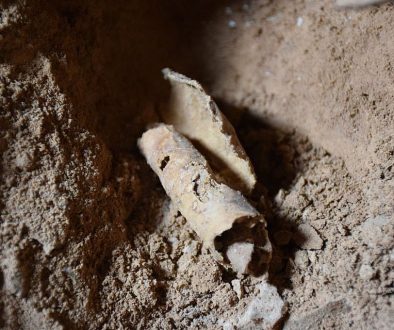Tsunami Reveals Ancient Ruins in India
MAHABALIPURAM, India (AP) – For a few minutes, after the water had receded far from the shore and before it came raging back as a tsunami, the fishermen stood along the beach and stared at the reality of generations of legends. Or so they say. Spread across nearly a mile, the site was encrusted with barnacles and covered in mud. But the fishermen insist they saw the remains of ancient temples and hundreds of refrigerator-sized blocks, all briefly exposed before the sea swallowed them up again.
"You could see the destroyed walls covered in coral, and the broken-down temple in the middle," said Durai, a sinewy fisherman who, like many south Indians, uses only one name. "My grandfathers said there was a port here once and a temple, but suddenly we could see it was real, we could see that something was out there."
Whatever they saw is back under water and out of sight. But a few hundred yards away, something else came to the surface. The tsunami scrubbed away six feet of sand from a section of beach, uncovering a small cluster of long-buried boulders carved with animals, gods and servant girls.
The Dec. 26 tsunami savaged hundreds of miles of shoreline across Asia. It killed at least 126,000 people in Indonesia and at least 31,000 in Sri Lanka. In India, 10,700 people are confirmed dead, with more than 5,600 missing.
Mahabalipuram, capital of an ancient kingdom and famous for its elaborate Hindu temples, escaped mostly unscathed, with only three dead and limited damage.
And there’s something else the tsunami gave back – tourists, drawn by heated headlines in the Indian media about a rediscovered Atlantis.
"People are coming to see what the tsunami dug up," said Timothy, who sells sea shells and plastic palm trees at a beachside souvenir stand. "Only because of these new things are people coming."
Tourism is a major employer here, a reflection of a spreading Indian middle class, and the coast road is lined with mom-and-pop resorts and cheap restaurants. If the tsunami scared most tourists away, in Mahabalipuram it also brought some back.
On sunny weekend days hundreds of people now come to take a look at the carvings and splash their feet in the ocean.
"Business is good these days," Timothy said, smiling.
But what did those fisherman see? Archaeologists laugh at the tales of Atlantis and say it may take years of undersea exploration to uncover the truth.
But nearly everyone around here knows the stories – cocktails of history and mythology that tell of the great port city that traded with China and Southeast Asia some 1,300 years ago.
This is a town made for legend. It is home to dozens of Hindu temples, baroque stone structures often covered with carvings. But legend speaks of its most famous temples: the Seven Pagodas, named for the vaguely pagoda-like style of Hindu temples in this part of India. Those temples, which according to myth are said to have once lined the shore, were so beautiful that the gods destroyed all but one – the so-called Shore Temple, a magnificently carved complex that is now considered a national treasure.
Some fishermen insist they saw more than the six vanished temples when the waters fell back. "There must have been at least 20," said Sunderasan, a young man, gesturing toward the sea. "We had no idea there were so many out there."
Archaeologists say excavations on shore and at sea were already under way before the tsunami struck, and that divers made promising finds of barnacle-encrusted blocks that appear man-made.
So officially, researchers express little surprise at what was exposed.
"The tsunami didn’t do very much at all," said Alok Tripathi, who runs the excavations for the Archaeological Survey of India. He dismisses the talk of 20 temples offshore, saying the fisherman believe "every stone is a temple."
But anonymously, fearing they’d be seen as callous, some researchers quietly acknowledge the tsunami revealed more than expected.
"From an archaeological perspective, maybe the tsunami was good. We found some new things," said one, pointing to the exposed boulders.
"But from a human perspective …" he said, his words drifting into silence. Finally he added: "There was a lot of deaths, a lot of damage, a lot of destruction."





